Time to Mature Tasting
White Burgundy 2010
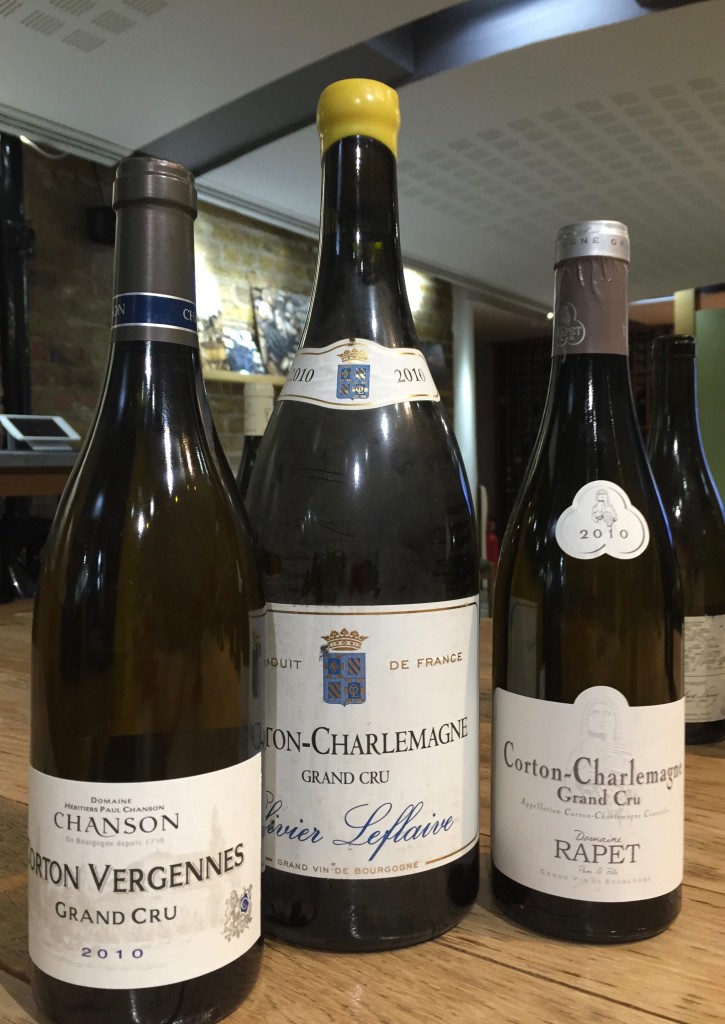
All too often Burgundy, especially white Burgundy, is swiftly consumed without allowing its true potential to evolve with ageing. The domaines in Burgundy which I visit often tell me they would like to see their wine given time to develop complexity. My ‘Time to Mature’ tastings are designed to chart how the vintage is progressing and to communicate, via the tasters, the advantages of allowing the wine to age.
I gathered a fine selection of the 2010s directly from the domaines who kindly donated them to this tasting, which was held at Berry Bros & Rudd in St James’s London. It should be pointed out that the wines were selected by the domaines and one must assume they chose the wines they felt would be ageing well. It’s important to bear in mind the wines have been kept in the best conditions.
The wines were tasted by wine writers, sommeliers and key Burgundy trade. Some sent their comments to me afterwards and these I have included.
2010 has always been a favourite vintage of mine, not just for the gorgeous, Pinot-pure, energetic reds, but for the whites, which had ripe citrus fruit, good concentration and fresh acidity. Whites of medium weight with nicely rounded body and moderate plus levels of alcohol (for the main part in the low 12% to low 13% region), so in general they are not rich.
The 2010s were somewhat overlooked. This was probably due in part to the season. The producers didn’t expect much form the mediocre season. The summer, with the exception of a warm start to July, had less sunshine and more rain than average. Fortunately the yields were small as poor flowering had resulted in coulure and millerandage and with good acidity and healthy fruit, a decent start to September saw the fruit ripen. However an electric storm which truck the lower part of the Côte de Beaune on the 12th September quickly ‘turned’ the more advanced vineyards.
It was the riper grapes which were most susceptible to botrytis. Logically this was the sunnier spots, so often it was the Premier and Grand Crus about which the growers were most concerned and picked first.
These were my comments on the style and quality of the 2010s when tasted in 2011 from barrel:
“The fruit is nicely in the ripe citrus spectrum (more tropical notes are in the minority). There is an emphasis on ripe lemon, but also plenty of fresh mandarin. (This orange note can stray into marmalade if there is botrytis!). Higher climats have more fresh lemon and white peach and flowers.”
“It is a very aromatic vintage, expressive on the nose, but also a marked aromatic palate enhancing the basic fruit/acidity/alcohol structure. Commonly occurring notes include orange flowers; pain epice (spicy gingery bread) and white pepper. There was really quite a lot of spice from ground coriander, cumin. Ginger is a bit of a theme – from ground to plenty of fresh grated ginger notes. There are high notes of mint and fennel. All very enticing.”
“Overall it is a little less ripe than the 2009, rounded certainly, but lighter in weight and with less alcohol and with a little more acidity than in 2009. The small berries had a good concentration of sugar and acidity; less sugar than 2009, but more acidity. They have quite a rich texture, but are not heavy.”
“However it is more difficult to generalise about 2010 than 2009 and for that matter 2008. The lightning/storm which turned the grapes means there is variation – a few days difference in picking and the profile changes to lower acidity, alcohol over 13.5 and altogether richer wines. As mentioned it tended to be the best terroir and the oldest vineyards which turned the quickest. Meursault is the most affected village as the grapes tend to be riper here earlier, also certain climat were more affected and some grand cru eg Bâtard had a lot of grapes turn. The main danger was flabby wines and less definition.”
“I was left, after several weeks of tasting, of an overall impression of balance in the wine. It’s an equitable vintage.”
“In addition to the balance, it may be considered a quality vintage for aromatic precision and terroir expression.”
“The terroir is more crisply precise in 2010 with the character of each climat nicely defined, more so at this stage than in 2009 and 2008.”
“This is a very good vintage. With an average summer, the wines could have been average, but they are not because the yields were so low. This has given the vintage intensity, not too much ripeness and firm acidity. This fresh balance and intensity should give them good potential to age.”
So how do the measure up to this early assessment. Have they fulfilled their potential? The short answer is yes. Given the assessment above still holds true, it seems sensible to include it.
Tasting on the 26th June in 2019 most of the wines were well balanced with fresh acidity, lightly rounded body, slim silky texture and good concentration. They were ripe, with a sweetness to the fruit, but not rich. The majority of wines showed good energy.
Excellent terroir typicite. It’s a certainly a terroir led vintage. It is much less vintage led than 2009 and 2008; the terroir and the domaine style were more apparent.
The wines are moving from fruity to more tertiary notes of sweet hay and toasted nuts, but are very youthful, more so than the 2009 and 2008s tasted in previous tastings with similar age (ie 8.5) years of maturity. The oak was nicely integrated.
There were more frequent notes of botrytis than I expected in the sample of 30 odd wines. It suggests that a maybe a little botrytis among the fruit at harvest has become more expressive with age. These wines have somewhat orangey aromatics and flavours, a little of which can be rather appealing, particularly when it stays in the more floral orange blossom register. Just a few strayed to a thicker texture and more toffee-ish with slightly lower energy and acidity.
There was a bitter note at the end of the palate several wines, sufficient be be worth noting. In general it was appetising and added some contrast and freshness, although it seemed somewhat strange as this was a vintage in which it was quite difficult to ferment the wines fully dry – many were left with 1.5g/l sugar. It often appeared with orange notes of botrytis, so they may be linked.
Many premier cru from Puligny, not only merited, but needed further ageing. Some 1er cru were at an awkward stage showing potential in structure, but not singing. A little flat footed maybe. I find white Burgundy can go through a bit of a dip around 5 to 6 years, before it starts to develop interesting secondary characters.. I have tasted the vintage regularly over the years and it didn’t ‘do the dip’ So maybe in 2010 this is a little later for some wines.
In contrast the grand cru, with the exception of Vincent Rapet’s austere Corton Charlemagne, which was battened down, were becoming rather accessible and expressive now, but not hurry as there is excellent capacity to develop over the next 10-15 years.
In comparison with the vintages we have tasted at the same time in their evolution, I found the wines better balanced, more energetic, more refined and youthful than the 2009s we tasted last year and of higher quality and potential longevity than both the 2008s and 2009s.
Domaine Jacques Carillon’s Perrières drew some negativity from the assembled tasters. I took the end of a bottle home with me as I felt there was nothing out of place, it was simply not showing much. It developed a long sweet mineral line by the next day and was still tasting well 4 days after opening it. It is unfair maybe to do this with one wine, as others may also have improved, but there was nothing awkward to resolve in this wine, it was just surprisingly muted and a little flat. Indeed there was a somewhat flat sensation with a few wines in the tasting – mainly in Puligny. I would leave these wines and see how they develop.
There was no sign of pre-mature oxidation in any wine. The two regional wines showed oxidation commensurate with their age and quality.
When to drink:
Village and smaller 1er cru. Now and over the next 3-4 years.
Best premier and the grand cru will will benefit from another 2-4 years and should last until 2026 and the very best until 2030.
Individual villages
Saint Aubin
There were only two wine submitted, which were of very different style. Both showed good minerality and energy and have developed complexity. I would not age them too much longer though. Now and for the next 2-4 years.
Meursault
Meursault was the most affected by the electric storm which turned the grapes. This remains the most inconsistent village.
However I was impressed with Domaine Comte Lafon, Clos de Barre. There still seems a lingering perception that the domaine style is full and rich, while for many years Dominique has been making a tighter, fresher, more elegant style clearly evident in this Clos de Barre. It’s a lieut dit on the flat with deep top soil, but the wine with compact and energetic… no doubt helped by the biodynamics.
I am not sure I would have submitted Genevrières as it is the most difficult of the three top 1er cru to hit the right note. I recall tasting the Gevevrières in barrel and remarking it was not the best vintage for this climat. While the three examples below are pleasant, they do not have the floral refinement, delicacy and minerality of the climat at its best. I found Latour Giraud the more ‘obvious’, but possibly also the most engaging, expressing the generous side of Genevrières. Bouzereau was quite elegant and streamlined. Remi Jobard more reserved and pared back, but a bit flat and lacking some energy. The three were different in style, but of similar quality.
The second division 1er cru can be a little heavy. Buisson Charles, Gouttes d’Or is typically rich, but there is plenty of matter. You are on safer ground with Perrières in 2010, for the minerality it brings to the party, not that we had any in this tasting. As a general observation, I would certainly be opening 1er Cru Meursault to check on progress, with the exception of Perrières for which it is likely to be rather early.
Puligny
Puligny presented the most most minerality and had two spot on ‘smaller’ wines – village and lighter premier cru. Village wine are often more interesting in Meursault, but in 2010 Puligny village wines were more consistent and fresher. Domaine Jacques Carillon village Puligny could almost be premier cru. Domaine Claude Bachelet, Puligny-Puligny-Montrachet, 1er Cru, Sous le Puits is a stunner.
The premier cru had length and intensity, but while some were a delight – poised and racy – there was a recalcitrant undercurrent. I feel there is no lack of potential here, but these wines need time.
While Domaine Leflaive’s Folatières is a lively and quite sophisticated wine, their Combettes seemed quite rough, while Etienne Sauzet’s was vigorous and compact and much more the style of Combettes I recall in the 2010s from barrel.
As a group Puligny probably needed the most time and I would wait another 2 to 4 years and there is no hurry.
Chassagne
At this moment in time Chassagne as a group were the most expressive, floral and spicy.
In 2011, tasting from barrel, this was my impression…
“What is notable for Chassagne this is year is the energy. Perhaps I was expecting the worst and perhaps because I tasted after Meursault, where some of the wines are a bit top heavy. It was a pleasure to find purity and intensity of fruit, but not overly ripe wines at all. The focus is on aromatics – be it flowers or spice – and there is plenty of spice in the vintage, and energy, with nicely defined palates without unwelcome blurring at the edges.”
This is still true today. They are aromatic with an easy harmony and balance, an engaging ripeness and silky texture. We had 1er cru wine from across the village, from lower sited Morgeot on clay to Romanée from thin soils at the top of the slope. All had good terroir typicité. They were accessible and enjoyable now, but still youthful – on the cusp of youth and something more complex. You could drink them now, but there was plenty of stuffing and the balance to evolve beneficially.
Grand Cru
It was difficult to make elegant Batard in 2010 as the climat was quite forward and ripe when the storm came and needed swift picking. Jean-Noel Gagnard’s wine is typical in presenting a burly, rich expression. Chevalier is retrained in comparison, delicate, intense, quite light bodied and fine boned with salty minerals.
Corton-Charlemagne and white Corton are truly on form. They were good from barrel and are fully living up to expectations. Eloquent terroir expression showing the different faces of the hill. I really enjoyed them and with exception of Rapet (a blend of en Charlemagne and Le Charlemagne on the border with En Charlemagne – ie cooler west face) they were opening up nicely, but this group of grand cru really showed potential to age.
Staying in Pernand, I have to mention Remi Rollin’s village Les Cloux, a warm village parcel, tucked behind the hill of Sous Frétille. It was sandwiched between grand cru and held its head high. It’s a good year for Pernand Vergelesses and the hill of Corton, without the austerity of a truly cold vintage and with uninterrupted ripening into later September.
These were my highlights.
Domaine Jacques Carillon, Puligny-Montrachet – over performed.
Domaine des Comtes Lafon, Meursault Clos de la Barre – over- performed, but no doubt priced like a 1er cru!
Domaine Marc Morey, Chassagne-Montrachet, 1er Cru, Les Vergers
Domaine Bruno Colin, Chassagne-Montrachet, 1er Cru, En Remilly
Domaine Bernard Moreau et Fils, Chassagne-Montrachet, 1er Cru Morgeot
Domaine Jean-Claude Bachelet et Fils, Puligny-Montrachet, Sous Le Puits-over performed.
Domaine Leflaive, Puligny-Montrachet, 1er Cru, Les Folatières
Domaine Etienne Sauzet, Puligny-Montrachet, 1er Cru Les Combettes
Domaine Remi Rollin, Pernand-Vergelesses, Les Clous – over performed, great value.
Domaine Chanson Corton-Vergennes and Domaine Rapet, Corton Charlemagne. Good value for grand cru.
Thank goodness there is still very little investment value in white Burgundy with the exception of a handful of domaines (eg Coche-Dury, Arnaud Ente, Lafon). Hence you are unlikely to find many 2010 white Burgundy on the market now. The only good reason to buy white Burgundy en primeur is to put it in your cellar to enjoy drinking in the future, hopefully with the complexity of age.
Tasting Notes
June 26th 2019
Regional
Bravo to Domaine Chevrot for submitting some regional wines. The Aligoté was pleasant and Hautes-Côte de Beaune, Chardonnay was holding up.
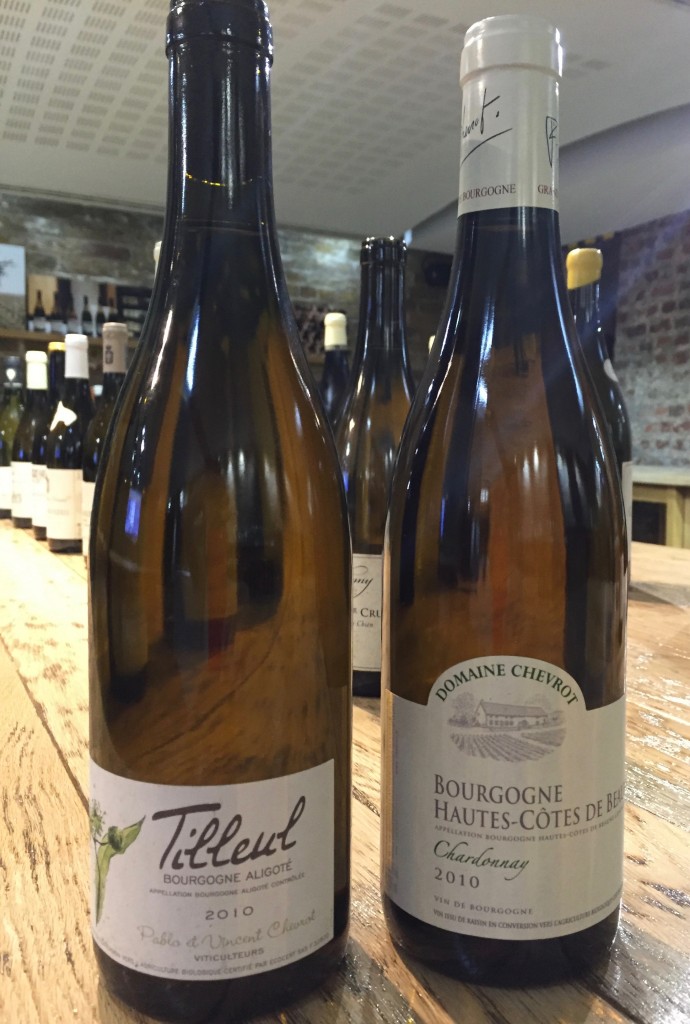
Domaine Chevrot, Bourgogne, Aligoté ‘Tilleul’
Mature wine. Quite fragile. This is a wine designed to be drunk in youth and it is simply ‘oxidising’ gently and pleasantly with age. It wafts across the palate with light hay and dried flower aromatics. It’s still fresh. Aligoté rarely has the stuffing to age beneficially for 8+ years so this is doing well. Drink now. 80
Domaine Chevrot, Hautes-Côte de Beaune, Chardonnay
This has some body and substance for a regional wine. Caramel aroma. Somewhat rounded. Toffee-apple characters but nicely balanced for it has a fresh slightly minty note. It doesn’t instantly drop off, but has a bit of a finish. It seems to be on a plateau. I cannot see it beneficially evolving, but nor is it fading. Score 80.
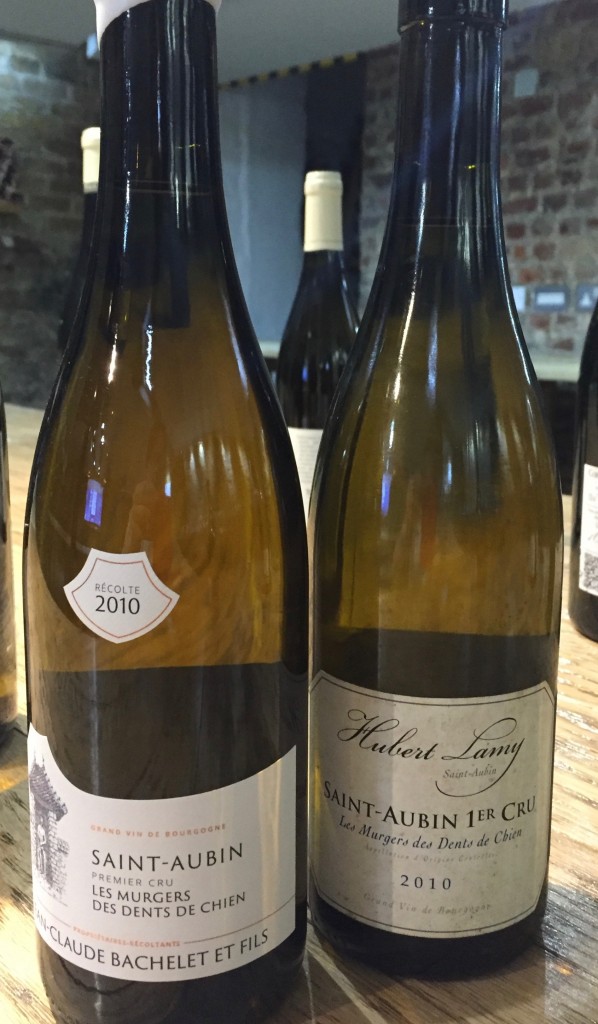
The two Saint Aubin are ready now.
Saint-Aubin
Domaine Hubert Lamy, Saint-Aubin, 1er Cru, Murgers des Dents de Chien
Quite ripe upfront on the nose and sweetness to the attack. Decent intensity. The straight palate and slim texture show the terroir well. Savoury, slightly dry salty finish of fair length. I quite like the pared back austerity, but would like to see more verve and intensity. Drink now and over the next couple of years. 2019-21. Score 16. or 86
Domaine Jean-Claude Bachelet et Fils, Saint Aubin 1er Cru, Murgers des Dents de Chien
Appealing and juicy upfront. Showing the nutty nuances of a mature wine. There is vitality and it’s quite well focused. Firm minerality. Sexier and more succulent than Domaine Hubert Lamy wine above. There is a touch of sappy bitterness on the savoury finish. Drink now and over the short term… I would not keep it too much longer. 2019-2021. 16.5 or 88
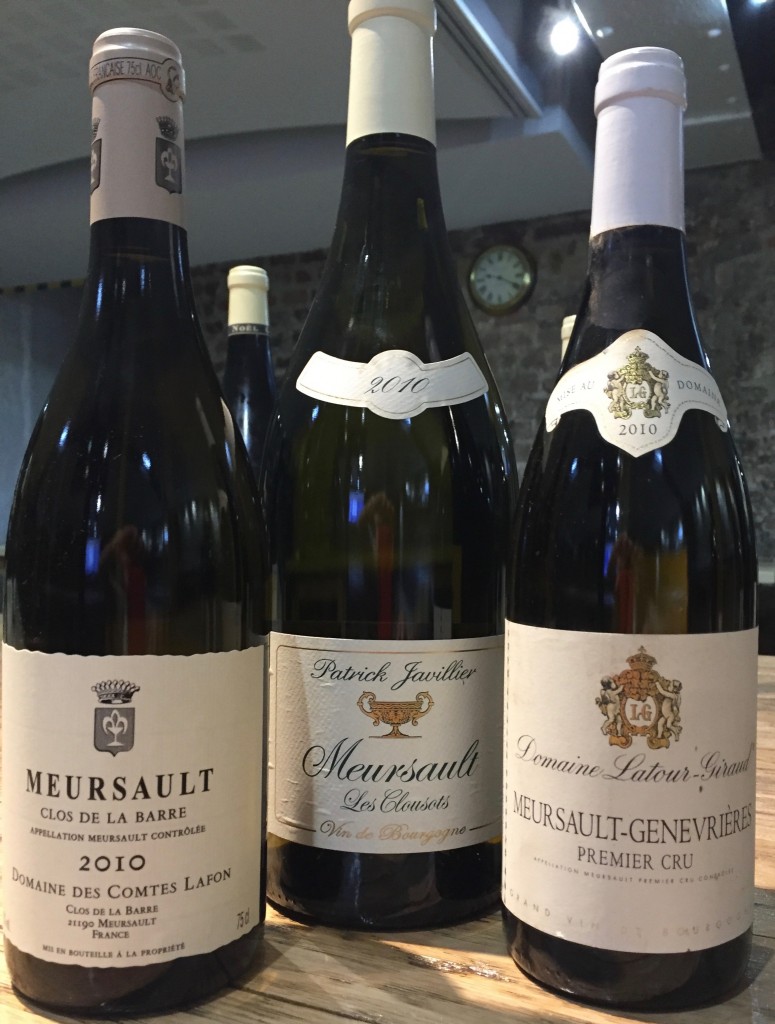
Meursault
Domaine Patrick Javillier, Meursault, Clousots (magnum)
Much more mature on the nose than the palate. Orange-like aromatics of botrytis. The palate is full-ish and rather richly rounded. Attractive in the mid palate, but it certainly a heavier style and, well, I cannot not say it’s energetically fresh. On the finish there is slight bitterness, which I don’t mind. It will give pleasure now for the richer style would work well with food. This is a magnum. On a plateau. I cannot see it evolving beneficially, so if you have this in a 75cl bottle, I would drink it over the short term. 2019-22 Score 16.25 or 87
Domaine des Comtes Lafon, Meursault Clos de la Barre
Juicy, compact and surprisingly dense, but well contained. Well honed. There is good energy and layering. It’s ripe, but with no lack of freshness underscoring the palate and on the well sustained finish. It’s impressive. Plenty of stuffing to age this wine further. It took a little time to open up, so decant it or wait. Certainly an exception to the general comment of village wines in Meursault underperforming. 2021-24. Score 17.15 or 90
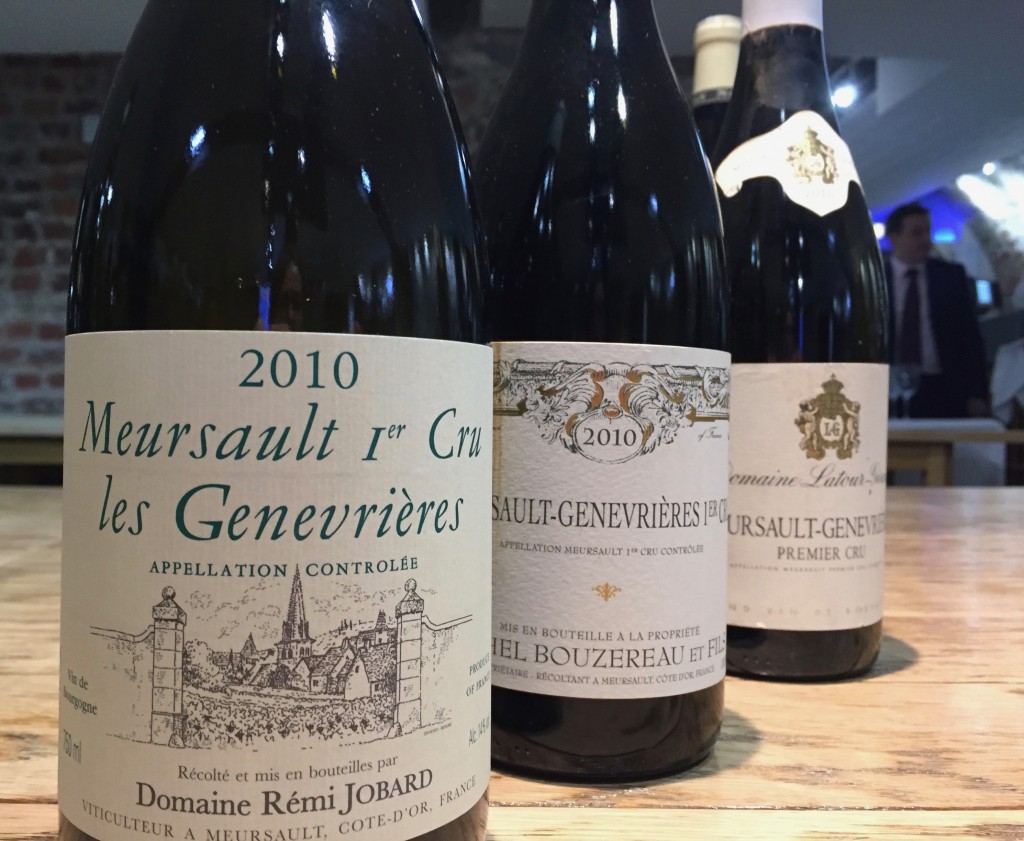
Domaine Latour-Giraud, Meursault, 1er Cru, Les Genevrières
Floral, broad and loose knit. Focuses to a rather spicy finish. It is plump with a crocheted texture. Quite nicely refined on the finish, which is fresh, light and a touch mineral. I would not keep it too long though. 2019-2022. Score 17.75 or 92.
Domaine Michel Bouzereau, Meursault, 1er Cru, Les Genevrières
Really rather honeyed and orange on the nose. Touch of botrytis maybe. Elegant, lightly plump palate. Quite relaxed, but with sufficient energy. Not especially intense, but an easy equilibrium. There is ‘sweetness’ to the fruit offset with a touch of bitter seville marmalade on the finish, which I quite like. Drink now and over the short term. 2019-22. Score 17.85 or 92.
Domaine Remi Jobard, Meursault, 1er Cru, Les Genevrières
Orange flower aroma. Rather engaging. On the palate it has body, but is pared back and more reserved. While it is well defined and nicely balanced, it is somewhat flat footed at the moment. A hint of bitter orange note works well to stretch the finish. This improved a bit as the bottle was left open. Maybe needs a little more time. Tempted to keep this another year and see. 2020-22. Score 17.5 or 91
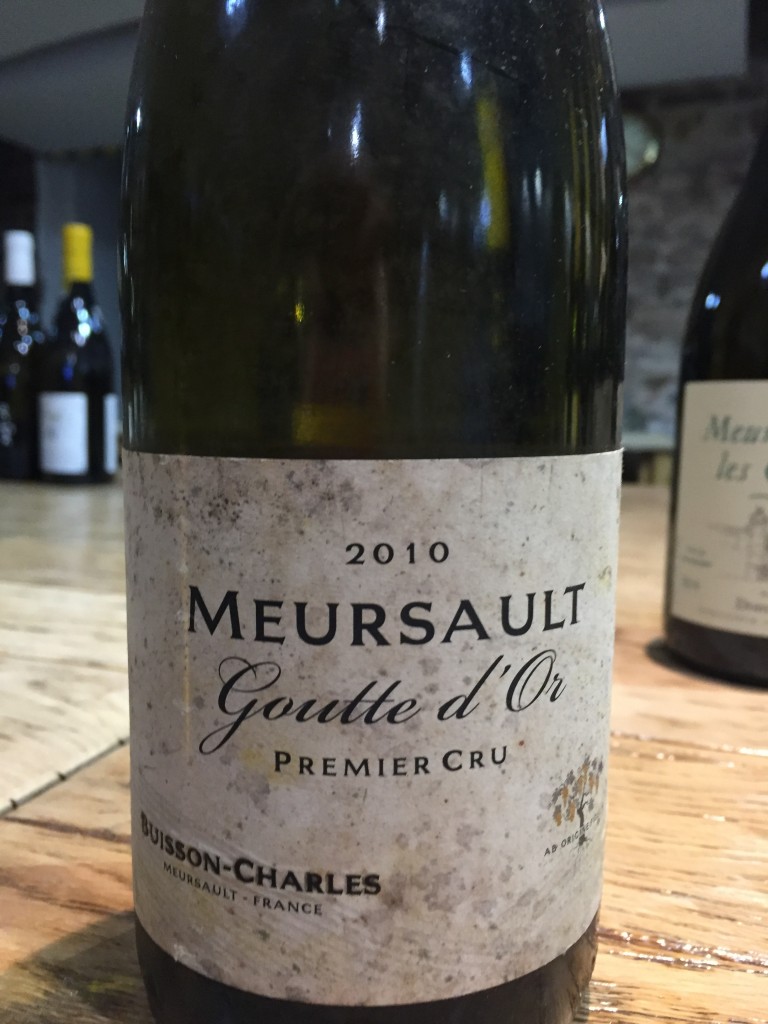
Domaine Buisson-Charles, Meursault 1er Cru, Gouttes d’Or
Full-bodied, rich and rounded with notes of greengage. It is very Gouttes d’Or. Good typicité. Patrick Essa like to pick late and fully explore the riper potential of his climats. Flavours of honey, butter and sweet hay. The density on the undeniably heavy mid palate is good and the finish is rich. There is no great hurry to drink this wine. I have a feeling it might refine and improve over the next 2 or 3 years. I would wait keep it a while. 2021-23. Score 17.85 or 92
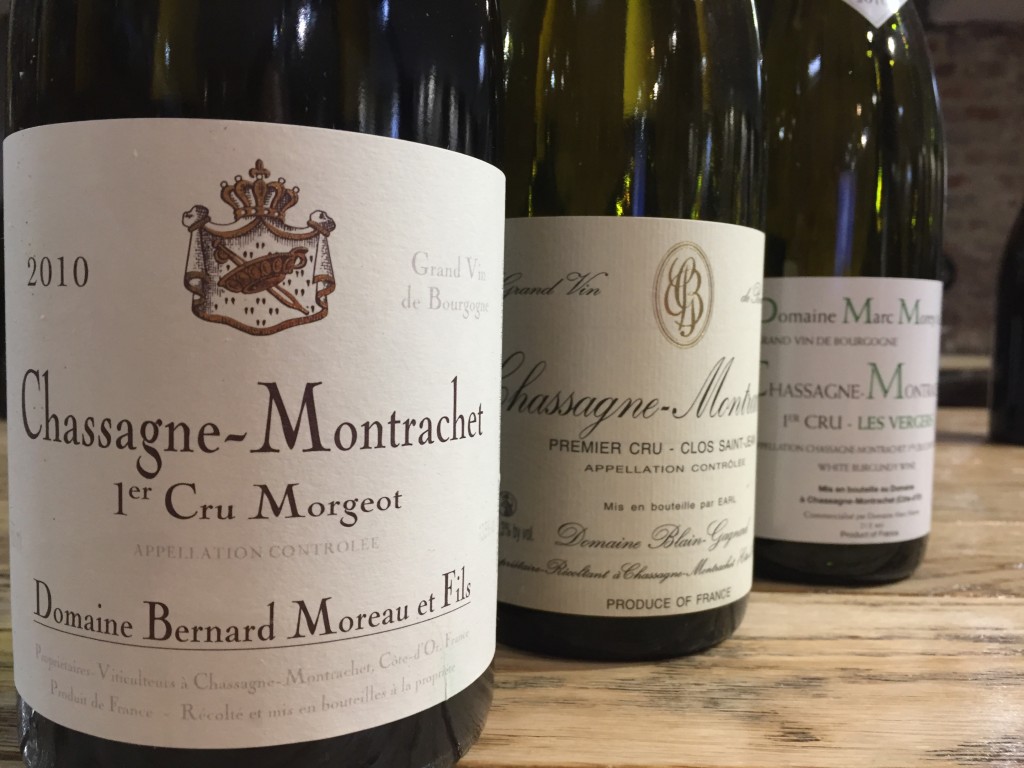
Chassagne-Montrachet
*Domaine Marc Morey, Chassagne-Montrachet, 1er Cru, Les Vergers
A very engaging up-toned aroma. Ripe citrus. So silky up front and supple skimming across the palate. This has elegance and charm. It is clean and fresh and very pretty on the finish. There is a harmony to this light, charming wine. Lovely now, but no sign of fading. I would drink it over the next 3 to 5 years. Not profound, but so appealing. 2019-25. Score 18.15 or 93
Domaine Blain-Gagnard, Chassagne-Montrachet, 1er Cru Clos St Jean
Slightly toffee-ish aroma and a rich, rather unctuous palate. It’s quite soft. It has some substance, which makes up for softer tasting acidity. It has some interesting flavours, with notes of vanilla fudge and a hint of coffee, but it lacks verve and excitement. I would tend to drink it near term. 2019-22. Score 17.5 or 91.
*Domaine Bernard Moreau et Fils, Chassagne-Montrachet, 1er Cru Morgeot
Appetisingly fresh aroma, almost minty. Tight on the attack. Nicely contained. It’s ripe, but vigourous. No lack of substance. There is a pithy, fennel and phenolic bite on the finish and quite some freshness which works well to offset the density of fruit. A proper Morgeot and a good food wine with plenty of matter. Drink now if you decant it, but this will age beneficially, quite possibly for another 10 years. 2021-29. Score 18.5 or 95.
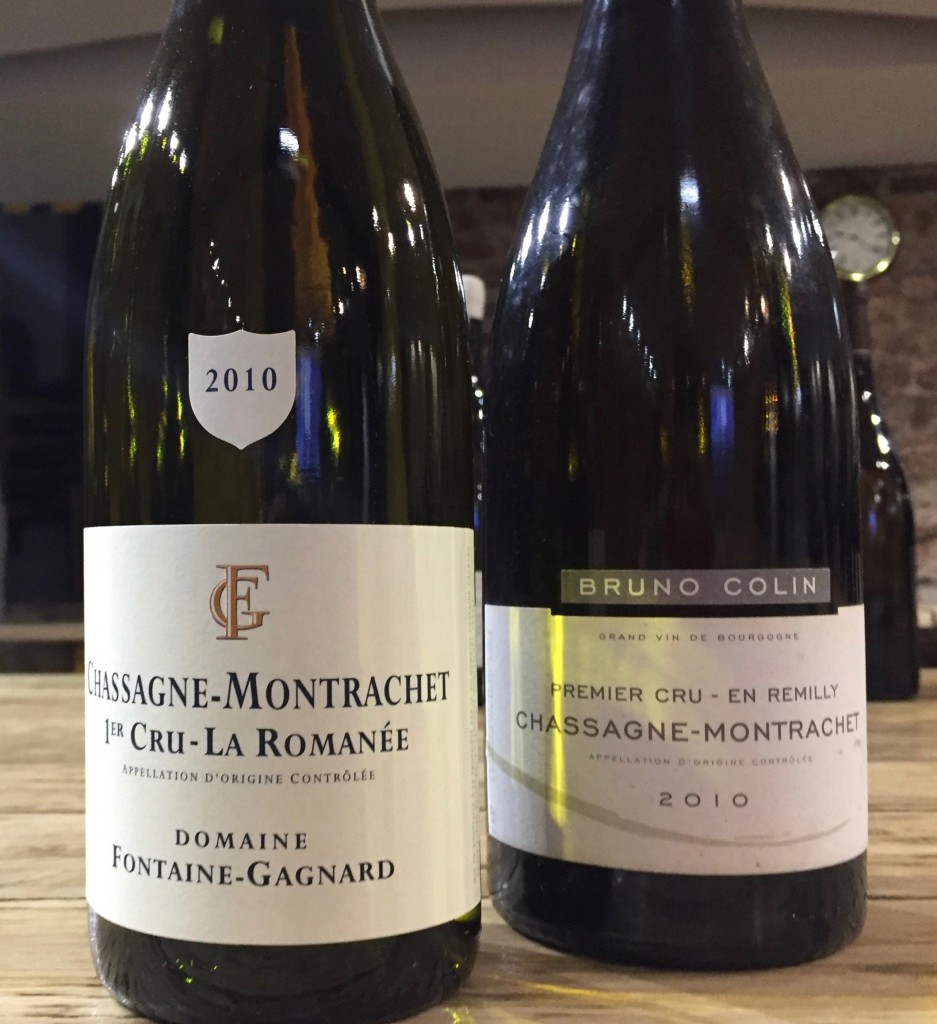
*Domaine Bruno Colin, Chassagne-Montrachet, 1er Cru, En Remilly
A floral aroma, but dried flowers, rather than fresh. A hint of cumin and ground coriander. Satin depth with fresh citrus acidity cutting through the smooth honeyed texture. It’s very alluring on the palate with a lively and well sustained, racy finish. It has kerb appeal. It is accessible, but has the energy and depth to last. 2019-2026 Score 18.5 or 95.
Domaine Fontaine-Gagnard, Chassagne-Montrachet, 1er Cru, La Romanée
Orange flower aroma. It’s silky textured and generous. I feel the aromatics slightly overwhelm the structure at the moment… they are quite exotically spicy with fresh and ground ginger while the structure is more refined, although maybe a touch lighter than ideal for ageing. There is a fine thread of acidity here which carries to the decent finish. I would start drinking this and monitor progress.. From 2019-22 Score 18.25 or 93
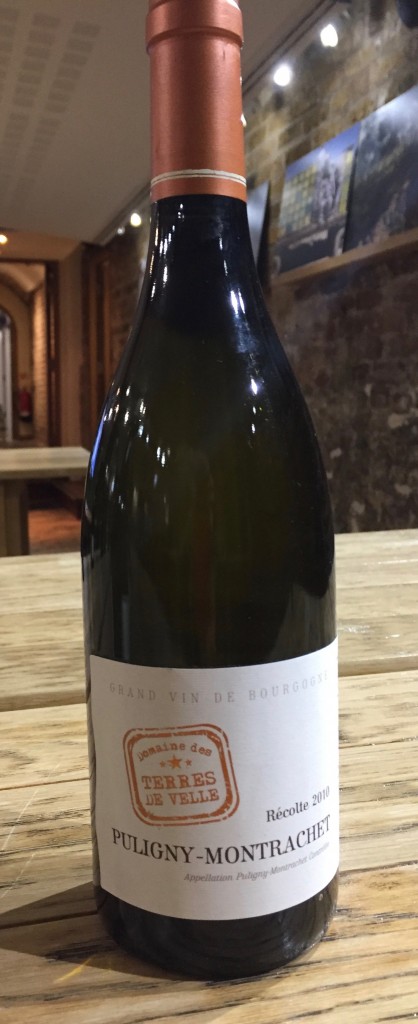
Puligny-Montrachet
*Domaine Terre de Velles, Puligny-Montrachet
Most attractive. Straight, well edged, fresh and mineral. It’s fully mature with delicious notes of hay and grilled almonds and a touch of lemon zest on the finish – giving it a light and pithy bite. Spot on. Drink now and over the next 2 or 3 years or so. From 2019-22 Score 16.85 or 90
*Domaine Jacques Carillon, Puligny-Montrachet
Restrained. Channelled line. This is refined, savoury mineral and precise. Sharply edged with excellent finish and presence for a village wine. Absolutely spot on and would give some 1er cru a run for their money. Some ageing capacity too. 2019-24. Score 17.5 or 91
*Domaine Jean-Claude Bachelet et Fils, Puligny-Montrachet, 1er Cru Sous Le Puits
Fresh toast aroma of mature wine. Vivacious, tight, high toned and straight. This zips across the palate with citrus an mineral freshness and energy. Light and clipped with delicious lemon balm aromatics on the palate. Love it. It’s not super ‘serious’, but it’s a delight. I can see this ageing rather well. It’s very well balanced and finishes with singing minerality. 2019-26. Score 18.25 or 94.
Domaine Pernot-Belicard, Puligny-Montrachet, 1er Cru, Champ-Canet
Exotic flowery aroma and palate. It’s loosely textured. Rather inviting. Somewhat ‘pink’ in flavour profile, but off set with a light freshness. It’s pleasant, but lacks somewhat in substance and length. To be fair these are young vines. Not a bad job at all! Drink now. Score 17 or 90
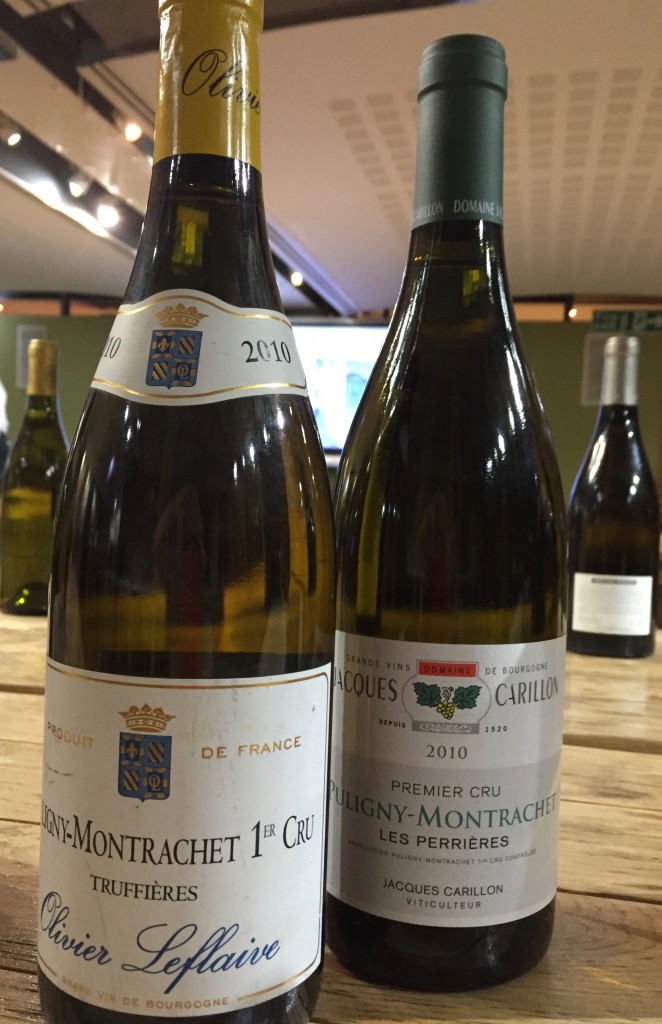
*Domaine Jacques Carillon, Puligny-Montrachet, 1er Cru, Les Perrières
Reserved aroma. Tight and well focused. Straight, well defined palate, but battened down. Just developing some mature Burgundy aromatics on the palate – lightly toasted macadamia nuts. This did improve significantly (as noted above, I took the little bit left home with me as I felt it strange it was underperforming and it developed a long sweet citrus and mineral line by the next evening. Fast forwarding it in its evolution like this, it was pure as a whistle and singing. It’s maybe not fair to do this with one wine and others may also have improved, but this was just not showing much at all. 2022-26 18.65 or 95.
Maison Oliver Leflaive, Puligny-Montrachet, 1er Cru, Les Truffières
Honeyed, orange flower aroma. Most ‘come hither.’ After the tantalising aromatics, it seemed slightly reduced on the palate. It did open up, but was lacking in verve and freshness. Appealing aromatics, but lacks a bit of structure for this delightful climat. I wouldn’t wait. Now and short term. 2019-21. Score 17.5 or 91
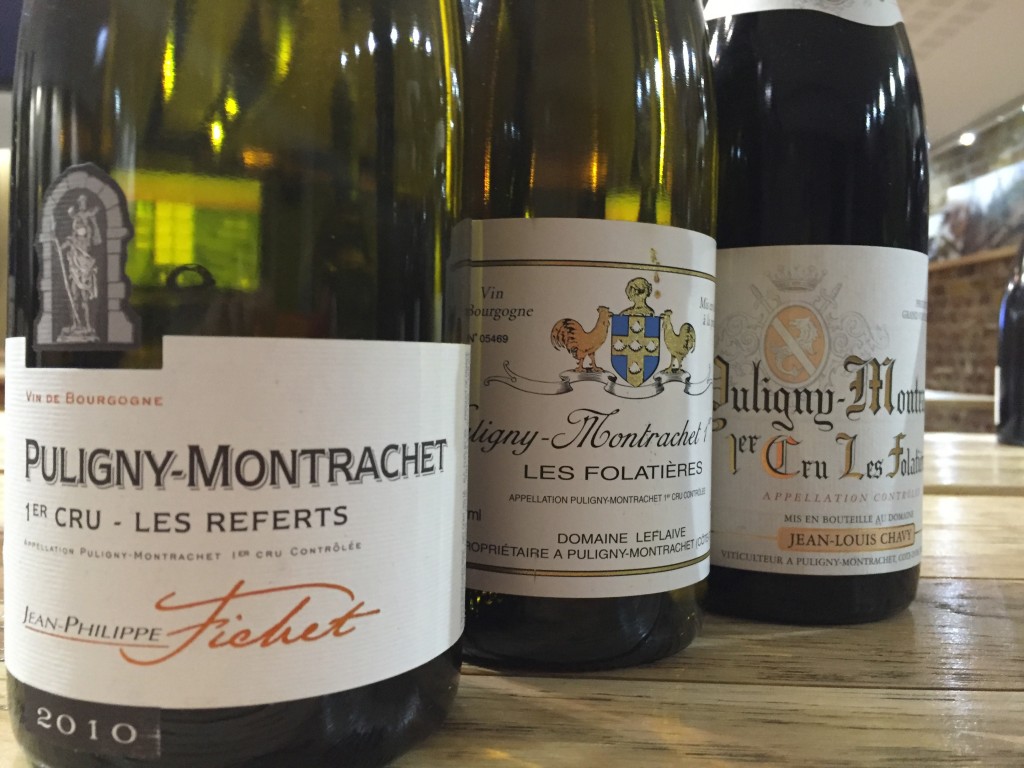
Domaine Jean-Louis Chavy, Puligny-Montrachet, 1er Cru, Les Folatières
Rather an energetic and intense aroma. Ripe strike and a silky rich texture. Aromas of toasted almonds and sweet, fresh hay. Decent depth and generosity to the palate. There is not a lot of grip, but it’s very pleasant with a sweetness on the well sustained finish. A very sound and accessible Folatières which is ready to drink, but with no hurry. 2019-23 Score 18.25 or 94
*Domaine Leflaive, Puligny-Montrachet, 1er Cru, Les Folatières
Floral and elegant with orange blossom and slightly honeyed notes. It’s ‘lighter’ bodied, but intense. Vivacious, streamlined and rather sophisticated. There is a delicacy to this Folatières, which carries to the fine, saline and pure finish. There is lightness of touch and aromatic precision. I really like it. 2019-26 Score 18.75 or 95/96
Domaine Jean-Philippe Fichet, Puligny-Montrachet, 1er Cru, Les Referts
It was rather reduced. Broad, full body which is certainly compact. It does lack a bit of oomph. Referts is a bigger wine and this is certainly on the chunky, robust side. It’s uncomfortable now. I think is room and possibly potential for improvement. Better to keep it and hope it evolves beneficially. 2021-24 Score 17.65 or 91
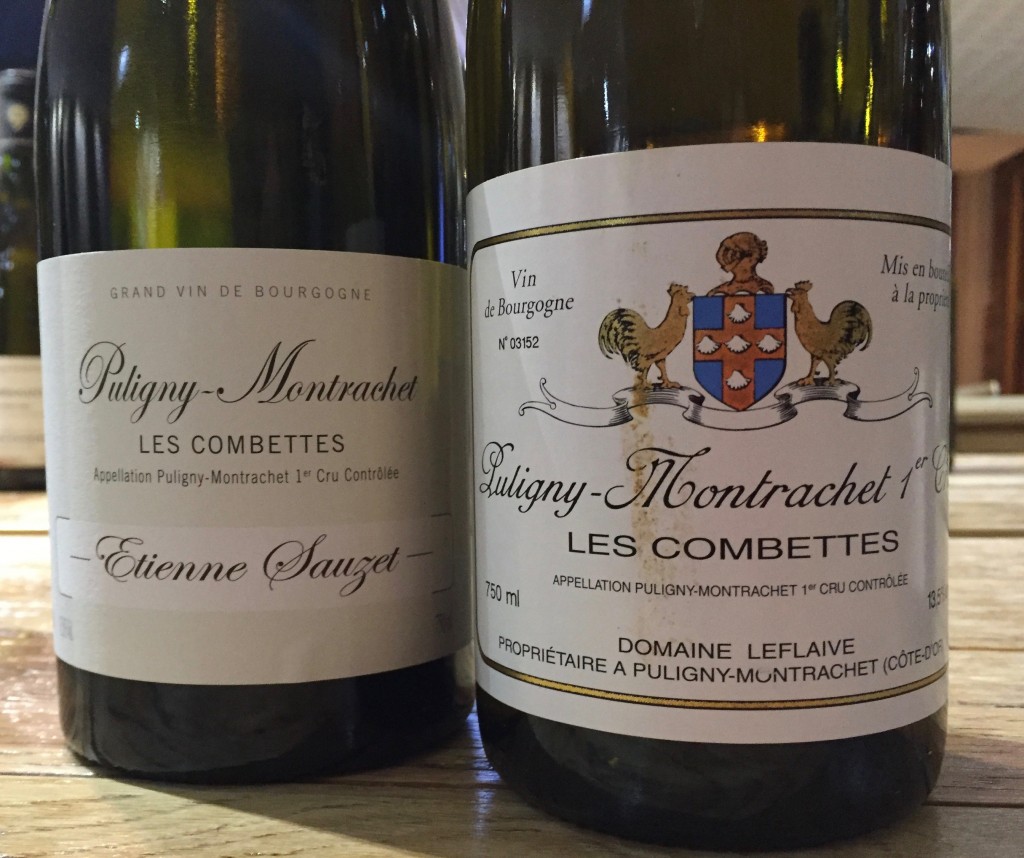
Domaine Leflaive, Puligny-Montrachet, 1er Cru Les Combettes
Orange and honeyed notes. It’s compact and has burly density and quite a powerful finish, but it does lack refinement. It’s a bit rugged. I would hang on to it and wait and see. 2022-24 Score 18 or 93.
*Domaine Etienne Sauzet, Puligny-Montrachet, 1er Cru Les Combettes
Focus and intensity. Well defined and layered palate. It has proper Combettes substance and is very fresh. The vital citrus finish with a touch of cold stoney sappiness I really like. Impressive and well sustained. It has grip. Really no hurry and this should age very well. From 2021-28. Score 18.75 or 95/96.
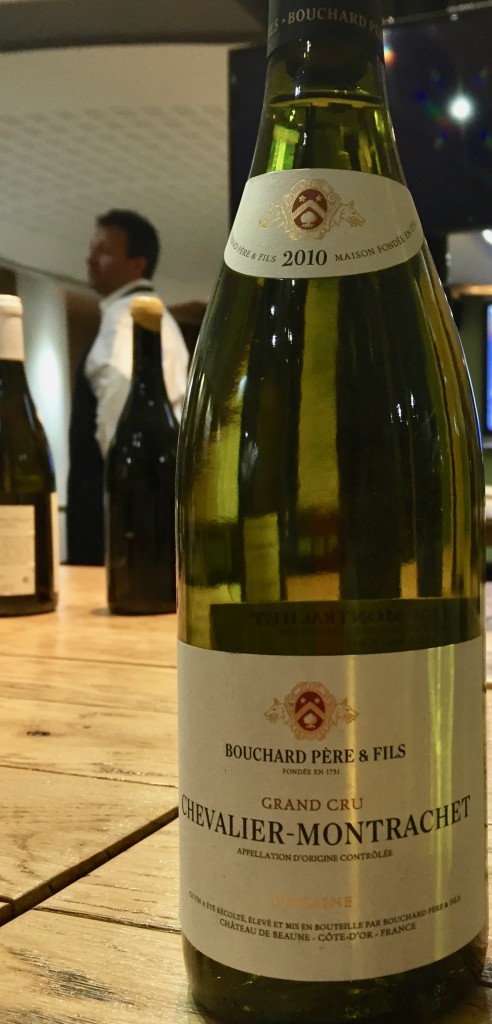
Grand Cru
*Bouchard Père et Fils, Chevalier-Montrachet
Focused. Pure, vibrant and saline. It’s rather light, but intense. Finely chiselled edges with cool saline minerality under the palate and a sustained savoury and sapid finish. It is refined. Not a showy wine. Quite accessible if decanted, but wait a little as there is no hurry. 2021-28/30 Score 19 or 97
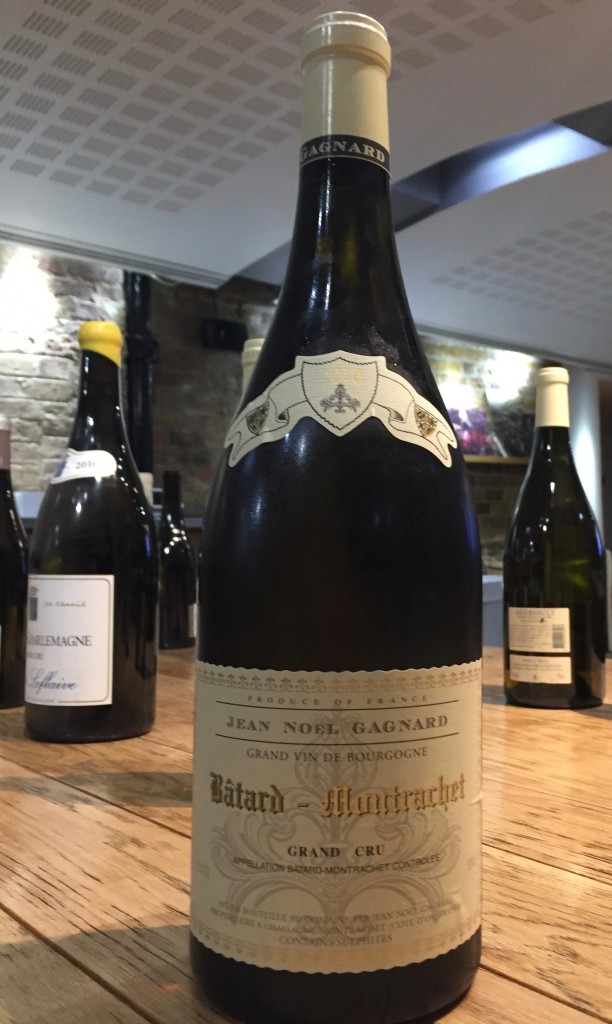
Domaine Jean-Noel Gagnard, Bâtard Montrachet (magnum)
Honeyed aroma with notes of orange blossom. Rich and full, almost unctuous on the front palate. It’s on the heavier, muscular side, but very open and expressive and quite juicy in the middle. A fulsome, burly richness then – some caramel flavours with sufficient sweet acidity to carry the finish. Some tasters found it rather over blown. However I would say it is sumptuous and invites drinking. From 2020-24. Score 18.5 or 95.
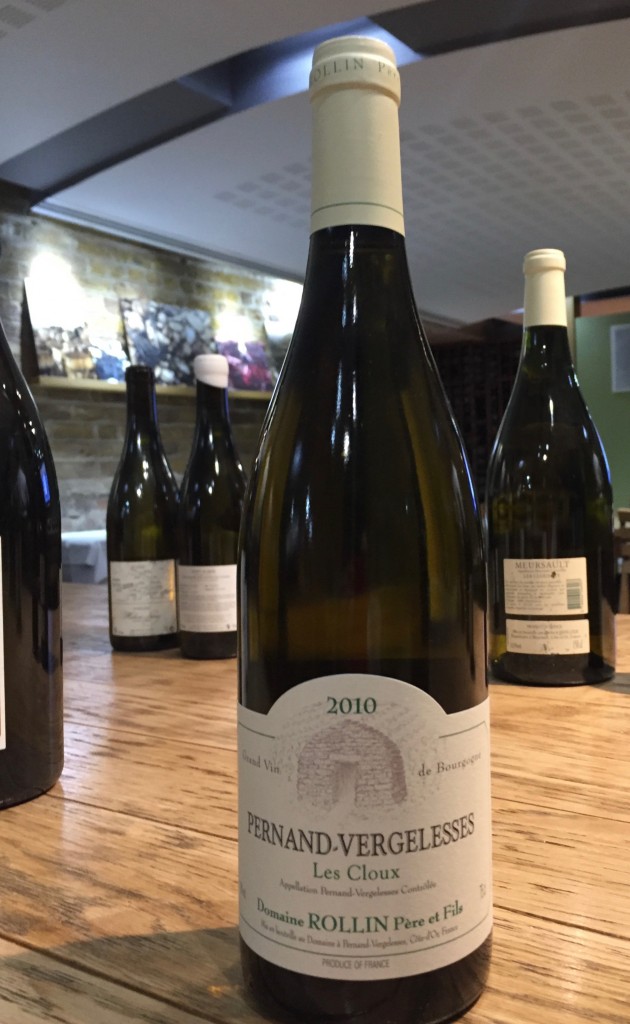
Pernand-Vergelesses & Hill of Corton
These are showing very well. Plenty of potential, even in the simple village wine from Remi Rollin. There is energy and intensity. Corton Charlemagne showed well in barrel and has plenty of potential to age. I would give them more time to maximise their potential.. another 3-5 yeas and should go the distance to 20 years overall.
*Domaine Remi Rollin, Pernand-Vergelesses, Les Cloux
This is spot on. Fully mature, very fresh, energetic. Really over delivers. Vibrant acidity. Zesty finish. It’s ripe, yet slightly austere and salty. Such a good little vineyard. The colder 2010 suits it well. Now, but no hurry. 2019-21 Score 17 or 90.

*Maison Olivier Leflaive, Corton-Charlemagne (magnum)
Aromas of new mown hay combined with fruity exuberance. Still very youthful, but it is a magnum. Generous, ripe and very well contained. This delivers. Plentiful depth. Savoury sapidity combines with sweetness on the well sustained finish. This gives a good deal of pleasure. In place now so you could drink this or keep it 2019-27. Score 19 or 96
Domaine Vincent Rapet, Corton-Charlemagne
Much more austere style. Straight, edgy, savoury, stoney. Not juicy. There is a richness of texture which with the savoury character need time to integrate. This Corton-Charlemagne needs time. The finish is firm, salty and persistent. A wine of marked sapidity. Maybe not a good moment now though. It’s too young, so hang on to this. 2022-30. Score 18.75 or 95
*Domaine Chanson, Corton-Vergennes
This has well honed muscularity and grip. Savoury power and intensity. Notes of sandalwood. It’s compact and dense with grippy minerality. Punchy, powerful and persistent finish. A finish with no lack of grunt. Wait. This is very early days for this wine. This needs time and has plenty of potential to age. 2023-30. Score 19.15 or 96/97
Some comments sent to me from the other tasters
The wines writers write their own pieces – see their websites or magazines
Jancis Robinson MW (The Times/www.jancisrobinson.com, Neal Martin for Vinous, Stephen Brook for Decanter. Sarah Marsh MW Oenologique (to be published in November).
Adam Bruntlett, Burgundy buyer Berry Bros. & Rudd.
I think in general the wines were very successful, and I was impressed that whilst a number were definitely ‘drink now’, none of the bottles felt prematurely past its best despite the broad range of quality levels. I personally wasn’t too upset by the botrytis character that perhaps you were more susceptible to than I! I felt it added an extra layer of complexity to some of the wines, and some of my favourites were seen by other tasters (eg Bachelet’s Puligny) to be heavily botrytised.
Terry Kandylis, Head Sommelier 67 Pall Mall
I think that the majority were showing very well on the day and of course few of them were on top form.
I knew that I would like the style of certain producers like Javillier and Carillon, which never fail to deliver to my liking with their precise and more mineral approach. Their wines are all about elegance and finesse, rather than body, weight and extract. Minimum use of new oak and bâtonnage gives a lighter sensation and adds on their drinkability factor. Still very youthful and fresh, without
There were some pleasant surprises, like the duo of Leflaive (Combettes and Folatières) that I found them surprisingly fresh.
Have to admit that I was expecting pre-mox issues here, due to my previous experiences.
Not sure if we were just so lucky to have 2 great bottles and there is bottle variation that we need to keep in mind, but the ones I tried they were very good bottles.
Especially the Folatières was outstanding. One of my favourites on the day if not the best one on the line-up for me.
For the Combettes, I prefer it from cooler vintages as I always find a bit too big to my liking, four-squared and heavy when from more powerful vintages.
Much more prefer the version from Sauzet, that I found more balanced, mineral and taut.
Guessing that Leflaive picks up a bit too late to get richness and weight.
Comtes Lafon Clos de la Barre was again a revelation, with it’s noble matchstick reduction that resembles almost Roulot in style rather than the fatty and buttery styles of the past. Much more precise and mineral.
Julia Sewell (Head of Wine, Hide and Hedonism in Mayfair)
Overall 2010 seems to be in a comfortable place; expressive and generally still quite youthful. I was impressed by the balance showing in many of the wines, with no element – whether oak, acidity, alcohol – overly prominent. It seemed that the wines from Meursault and Chassagne had fared slightly better over the last 9 years, whilst in general the Pulignys were a little less vibrant. For me, the wines that really stood out as exceptional were the Comtes Lafon Clos de la Barre and Bernard Moreau Morgeot – one vibrant and expressive, the other compelling and youthful.
Meursault
The three Genevrieres showed a distinctive floral, perfumed character that really differentiated them from the rest of the appellation. Overall the Meursaults benefited from the roundness that comes with bottle age, and had both broadened and increased in their focus.
Chassagne Montrachet
Wines had a more tangerine-like citrus note, and were perhaps at a quieter point in their development. Expressive, but as if holding something back.
Puligny Montrachet
Overall the wines were somewhat more developed in their character; less perfumed and showing a stronger kernel/walnut note on the finish. It was a subdued, waxy character that gave these wines less appeal than the other appellations. However, the Jacques Carillon 1er Cru Perrieres had a freshness and brightness in contradiction with this generalisation; my notes say ‘concentration and mineral length’.
Underperformers
I had high expectations of the following and perhaps this is one reason for judging them more harshly/
Hubert Lamy St Aubin – the creamy element of the wine that in its youth is so distinctive and appealing had evolved to rather mask the other characteristics with an almost cheesy lactic note.
Fontaine Gagnard Chassagne 1er la Romanee – in comparison with the other Chassagnes, it showed a little less energy and verve. Perhaps it was just this particular bottle that hadn’t weathered so well.
Domaine Leflaive Puligny 1er les Combettes – after the Folatieres (my #2 pick of the Pulignys), this disappointed slightly. The nose was far more developed, and had an odd green-bean dustiness to it, although the palate was much more youthful and perhaps these scents were indicative of a wine that just needs time to breathe before tasting.
Grands Crus
I felt these wines, like the Chassagnes, were a little subdued at this moment of tasting; not lacking in concentration, but simply not showing their fullest expression. The Corton Charlemagne from Maison Olivier Leflaive had the most distinctive sense of place, but perhaps not the latent concentation of the rather quieter Vincent Rapet.
Ageing potential
Grands Crus – wait another 3-5 years to see these wines start to open up again. The Corton Charlemagnes have a solidity to them that suggests medium-term ageability.
1er Crus – Meursault and Puligny drink now or hold; they are open and expressive now, and would likely remain this way for some time. Chassagne hold another 2-3 years before opening, and then like the other two villages they may plateau.
Gearoid Devaney (Cabotte in London)
My thoughts were that overall the quality level was high, I enjoyed that there was some vintage definition, with a sense of precision and drive through the core of most of the selection and an encouraging energy that gave me the overall feeling that these will age well for many years to come. The best wines were full of energy, refreshing acidity and minerality, that made me want for more. Also, important to note that this vintage also allowed the terroir and winemaker style to show through. I liked both St Aubin’s, Lafons Clos de la barre was fantastic, full of flavour, concentration and complexity, with a salty mineral finish. I didn’t want to seem biased but I really believe Alex’s Morgeot was the stand out wine in Chassagne. In Puligny the quality level was more homogenous with the exception of the disappointing Chavy Folatieres, The Leflaive Folatieres was a real highlight for me, tight and tense with so much definition along with the Combettes from Sauzet, which had real intensity and purpose, with satisfying mouth feel and length. The Batard from Gagnard was tropical and over blown for me but I did enjoy the Corton-Charlie from Leflaive.
Overall though the quality was high and the 2010’s can be considered a good but for those who have them in their cellars.
Jason Haynes, Flint Wines
What was pleasing for me was that the vintage didn’t dominate the wines. What I mean by that is that the wines were either good or bad (less good) because of the quality of the producer not because of the vintage over-riding the influence of the domaine. There was a vintage style clearly, and this was especially evident in the best examples, but it merely allowed the wines to express the stylistic and qualitative differences of the vigneron.
The best wines were still young, coiled and lively with plenty more in the locker. It’s a vintage I liked a lot en primeur and I never understood some of the negativity surrounding it, negativity which seemed to increase when the excellent 2014s were released. I found no premature oxidation. Again, in the best examples, I found tension, balance, some dry extract (not to the same degree as the 2014s, but present) length, poise, substance and complexity.
My highlights were the following wines:
The St Aubins were both excellent and yet so different in style, though very true to the style of wine the 2 domaines produces. Lamy all steely and angular, Bachelet, rich and seductive.
Chassagne Morgeot, Moreau – not the best vineyard in Chassagne but this was perfectly balanced and fresh and still seemed to have its best years ahead of it
Puligny, Carillon – I thought this very classical, top notch for a village wine and I preferred it to his Perrieres, which, for me, was not singing on the day
Puligny Folatieres, Leflaive – Intense, harmonious and a lovely mix of richness and vibrancy. In fact it was everything the Combettes wasn’t!
Puligny Combettes Sauzet – this opened up nicely, I preferred it to Leflavie’s Combettes but not Leflaive’s Folatieres
Pernand Vergelesses, Rollin – sandwiched between 2 Grands Crus this massively overperformed. Lively yet concentrated, this was probably the value of the whole tasting
Corton Charlie, Olivier Leflaive – this opened out nicely and showed good typicity and concentration. In contrast the Batard got sweeter and clumsier as it warmed up
Meursalt, Lafon – I wasn’t sure about this initially but it started to show some quality elements with air and improved past the Javillier Meursault which was quite old school in style
Couple of disappointments:
Chassagne La Romanee, Fontaine Gagnard – I would have expected more from this vineyard in this vintage. It lacked intensity of fruit.
Puligny Combettes, Leflaive – after the Folatieres I found this a great disappointment and going nowhere fast
Puligny Referts, Fichet – too rich and blousy and not in keeping with the style of the vintage.
Giles Burke-Gaffney, Justerini & Brooks.
An impressive, dare I say surprising, tasting. Thanks again for organising. The surprising element was the lack of prem-oxed wines. Almost all were in good condition, I thought one exception was a teetering Pernot Belicard. Some wines at the lower end were tiring a little but nothing more than you would have expected and still showed well enough. Certain wines showed more unctuosity alcohol and exotic fruit, recalling the botrytis that affected some of the crop, these were fine and still very much alive but offered less excitement and ageing potential. For me, though, the very best wines in the vintage are clearly still very youthful indeed, they have a drive and energy. I was thrilled by how many of these wines there were. High acidity was a common feature across the tasting but where it melded into ripe but not excessively ripe fruit, you have a beautiful and seamless marriage. The wines that embodied these qualities most in this tasting were from Puligny, which for me was the most consistent commune. Chassagne was a notch down but still good and above the less consistent Meursaults but perhaps this was more to do with the selection of producers rather than commune traits. Corton was the least well performing but this to me feels like a question of commune and not producer. Then again, it was a small sample to judge on.
My star wines –
Comte Lafon Meursault Clos de la Barre
J-C Bachelet Puligny Sous le Puits
Domaine Leflaive Puligny Folatieres
J-P Fichet Puligny Referts
Sauzet Puligny Combettes
Bernard Moreau Chassagne Morgeot
JN Gagnard Batard Montrache
Domaine Jacques Carillon, Puligny Perrières
Domaine Remi Rollin, Pernand-Vergelesses, Les Cloux

